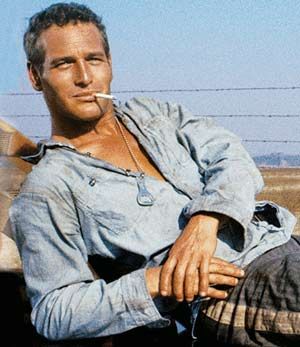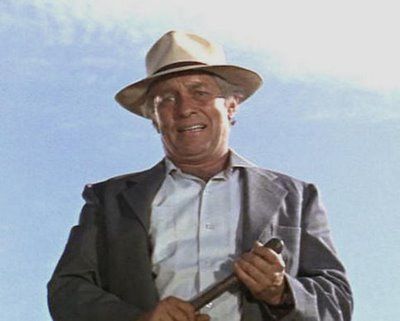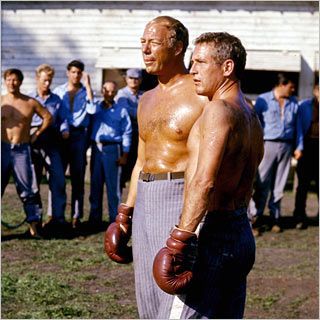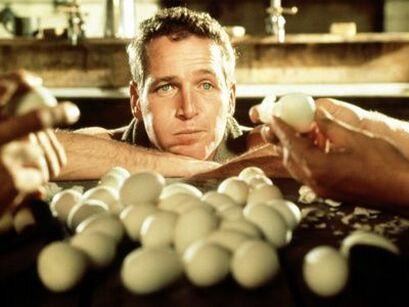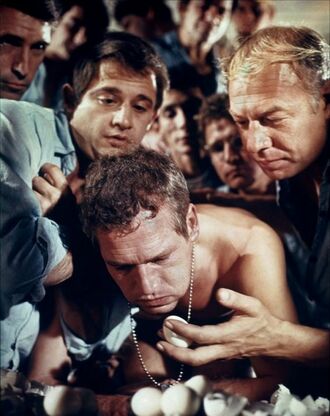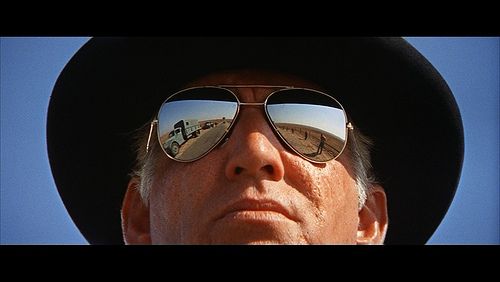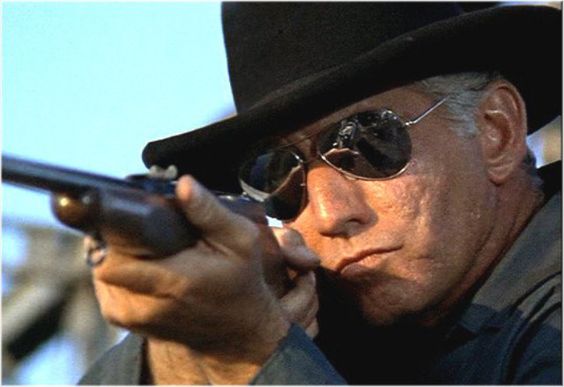Introduction:
Cool Hand Luke was released in 1967 by Warner Bros & stars Paul Newman, Strother Martin & George Kennedy, telling the story of an anti-authoritarian’s struggles on a prison chain gang. The film was originally set up at Columbia Pictures, but they were so dissatisfied with the ending that they dropped out. Warner Bros., who had a tradition dating back to the ‘30’s of having conflicted heroes (Public Enemy (’31) & Little Caesar (’31), to name a couple) stepped in to release the Jalem Productions release. Jack Lemmon, the principal owner of Jalem, had originally considered playing Luke, while also considering Telly Savalas, but Newman asked in, even before the script was written, and was given the part. Director Stuart Rosenberg had discovered Don Pearce’s novel in a .19 book bin & brought it to Jalem. Rosenberg, who had never directed a feature film, and was known for his work in television & Pearce, who had never written a screenplay, made an interesting pair to make a major studio release. Pearce, who had gone from the merchant marines, to safecracking & counterfeiting used some of his real-life experience on a chain gang for the story, but admitted that 1/3 was his life story, 1/3 was invention & 1/3 was pure bullshit.
Cool Hand Luke was released in 1967 by Warner Bros & stars Paul Newman, Strother Martin & George Kennedy, telling the story of an anti-authoritarian’s struggles on a prison chain gang. The film was originally set up at Columbia Pictures, but they were so dissatisfied with the ending that they dropped out. Warner Bros., who had a tradition dating back to the ‘30’s of having conflicted heroes (Public Enemy (’31) & Little Caesar (’31), to name a couple) stepped in to release the Jalem Productions release. Jack Lemmon, the principal owner of Jalem, had originally considered playing Luke, while also considering Telly Savalas, but Newman asked in, even before the script was written, and was given the part. Director Stuart Rosenberg had discovered Don Pearce’s novel in a .19 book bin & brought it to Jalem. Rosenberg, who had never directed a feature film, and was known for his work in television & Pearce, who had never written a screenplay, made an interesting pair to make a major studio release. Pearce, who had gone from the merchant marines, to safecracking & counterfeiting used some of his real-life experience on a chain gang for the story, but admitted that 1/3 was his life story, 1/3 was invention & 1/3 was pure bullshit.
Production began in Stockton California on a set that had been rendered to look as much like the prison camp Pearce had spent time in as possible. Pearce wasn’t fully sold on Newman as the lead, however, believing the 42-year old was too scrawny to play his hero. Pearce also wasn’t fond of movies folks in general and made a point of starting a fist fight on his last day on the set. The cast was made up of a collection of little-known TV actors & bit players, most of whom would go on to later fame. Harry Dean Stanton, Wayne Rogers & Dennis Hopper all distinguished themselves, but it was really Strother Martin, a TV & western actor & George Kennedy who really stood out. Kennedy famously & successfully campaigned for an Oscar nomination, noting “the moment I won my salary went up 10 times & I didn’t have to play the heavy anymore.” One of the interesting casting choices was the one that didn’t happen. Bette Davis was offered the part of Luke’s mom, but turned it down. The part went to Jo Van Fleet who had also played James Dean’s mother in East of Eden (’55). –(Just one in a string of coincidences that link Dean & Newman).
Newman thoroughly enjoyed his time making the film, particularly the most famous scene in the picture, where he bets that he can eat 50 hard boiled eggs in an hour. According to Newman he never swallowed a single egg. When pressed by an interviewer why he diverged from his method acting roots in authenticity, Newman admitted that realism ends when you have to swallow 50 eggs. He did, however, teach himself to play the banjo for perhaps the most poignant scene in the film. Newman was always bothered by the banjo scene, however, because he repeatedly made the same error in take after take & finally Rosenberg printed & used one of the flawed tunes (Try to find the error, it’s not easy). If the egg scene is the most famous, then the car washing scene is a close second. Filmed out of sequence with the reaction shots that were edited into the scene, Joy Harmon, who played the girl, later claimed that she had no idea of the double entendres throughout the scene. The rest of the cast, however, was able to watch the scene being shot for ‘motivation for their reaction shots.’
Newman thoroughly enjoyed his time making the film, particularly the most famous scene in the picture, where he bets that he can eat 50 hard boiled eggs in an hour. According to Newman he never swallowed a single egg. When pressed by an interviewer why he diverged from his method acting roots in authenticity, Newman admitted that realism ends when you have to swallow 50 eggs. He did, however, teach himself to play the banjo for perhaps the most poignant scene in the film. Newman was always bothered by the banjo scene, however, because he repeatedly made the same error in take after take & finally Rosenberg printed & used one of the flawed tunes (Try to find the error, it’s not easy). If the egg scene is the most famous, then the car washing scene is a close second. Filmed out of sequence with the reaction shots that were edited into the scene, Joy Harmon, who played the girl, later claimed that she had no idea of the double entendres throughout the scene. The rest of the cast, however, was able to watch the scene being shot for ‘motivation for their reaction shots.’
Overall, Newman was completely satisfied with the picture, telling a visitor to the set that “there’s a good smell about this” (P.217) & he was right. When the picture was released in November of 1967 it was generally praised by critics, although some thought cinematographer Conrad Hall’s images were to clean & too pretty for the gritty reality of the prison farm. Cool Hand Luke did pretty strong box office, finishing #19 for the year, even though not releasing until November. With such convention shattering films like The Graduate & Bonnie & Clyde released along with social issue films like In the Heat of the Night & Guess Who’s Coming to Dinner all being released in ’67, the Oscars were expected to be tightly contested. Inexplicably, Dr. Doolittle received the 5th Best Picture nomination, instead of Cool Hand Luke. The film did receive 4 total nominations, with Kennedy winning for Supporting Actor, while Newman lost to Rod Stieger’s racist sheriff from In the Heat of the Night. It was Newman’s 4th Best Actor loss without a win.
Without question Luke is one of the 2 or 3 signature rolls that Newman played in his career. His mix is grace, determination, stubbornness, swagger & resiliency resonated with audiences of the late 60’s just as surely as it does today.
Without question Luke is one of the 2 or 3 signature rolls that Newman played in his career. His mix is grace, determination, stubbornness, swagger & resiliency resonated with audiences of the late 60’s just as surely as it does today.

